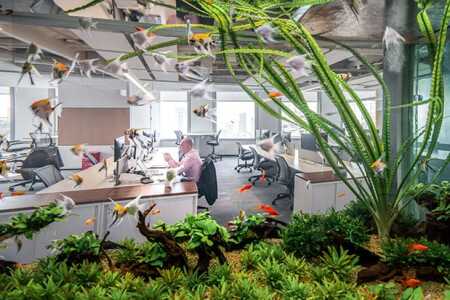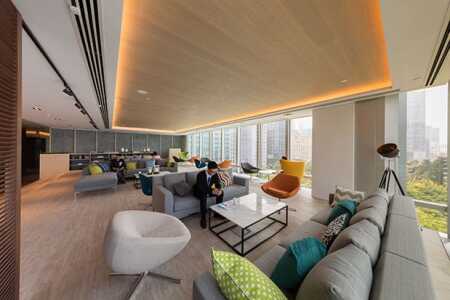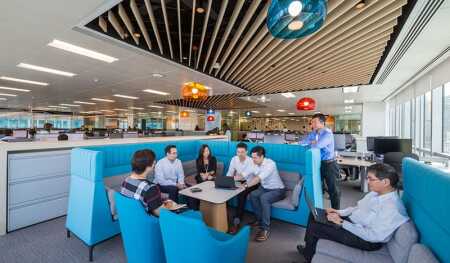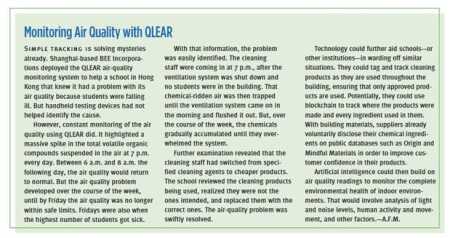Visit the Jones Lang LaSalle (JLL) office in Shanghai, and you will find that the fit-out of the space in the HKRI Taikoo Hui development qualified it as the first property in Asia to win Platinum WELL recognition, awarded by the International WELL Building Institute for JLL’s commitment to the health and well-being of the space’s occupants.
However, you may not immediately notice you have entered an office. Like a trendy hotel or movie theatre, the JLL space has no traditional front desk. Visitors move straight into an open-plan lounge with a double-sided island sofa and plush chairs. The “reception desk” is a four-seat table set to the side of a large stand-alone transparent digital screen, past which you will immediately see floor-to-ceiling windows and bar seats in an open-plan area.
The JLL logo and colors are the key features the space shares with a traditional office. Elsewhere, there is the gray, hot-desk bank of office tables, as well as computer screens with ergonomic chairs and sit/stand desks. Other work areas include a café with a reclaimed-wood floor and collaboration booths that would be at home in first class on Singapore Airlines.
Another design feature is the “15-minute room,” a bright-yellow enclosed office that is standing-room only—a comfy “padded cell” with wall mounts to lean on. It also accommodates about 15 people, a typical team size, with the lights timed to go off after 15 minutes—the length of the typical human attention span. It cannot be booked ahead of time, unlike other spaces in the office.
This is one face of how smart buildings operate in Asia today. The structure both accommodates and guides its occupants. It enables them to do what they want to do and encourages them to do it right. Besides WELL status for its benefits to physical and mental health, the office has also earned a Platinum rating under the Leadership in Energy and Environmental Design (LEED) system, devised by the U.S. Green Building Council, for its commitment to sustainability and the environment.
It certainly takes effort and expense to achieve such designations. But JLL, as a company advising multinationals such as the insurer Prudential and home furnishings retailer IKEA on how to design their spaces, believed it had to “walk the talk,” says Anthony Couse, the company’s Asia Pacific chief executive officer. The company committed to producing a “sustainable workplace that is healthy and productive for our clients and our people, and that puts the human experience at its heart,” he says.
What Is a Smart Building?
Companies such as Citigroup and property developers Grosvenor and Lendlease are increasingly deciding that the added investment to get third-party “well” certifications is more than paid back by greater productivity and loyalty from staff. At the root of this drive has been a shift in thinking about what it means for a building to be smart.
The word means different things to different people, notes Eli Konvitz, director of urban development and design for Asia at Atkins, a U.K.-based design, engineering, and project management consulting firm. Smart started as a supply-side idea driven by big tech companies trying to sell sensors, infrastructure, and services based on the premise that Big Data would transform cities.
Today, however, the concept is shifting to encompass an ongoing flux of factors like design, governance, implementation, and, yes, technology that all work for people.
The reality is that, in the age of the millennial, people want to live and work in more-sustainable, healthier, livable, better-governed, and efficient places. Under this expanded meaning of the term, smart should lead to human benefit—not to a vast machine that ultimately is just a tool. “That shift in thinking is key, as it takes us back to what we’re trying to achieve and for whom we’re doing it,” Konvitz says.
The first step in creating smart buildings in Asia may have to be taken at the government level. Regulators likely need to mandate improvements in the region’s existing structures and generally poor building standards. “For every Citi Tower, how many bog-standard [basic] housing blocks or commercial buildings are built with no insulation, single glazing, and inefficient HVAC systems?” Konvitz asks.
That said, the basics of building smart are not expensive, and not even new: in Europe, insulation and double glazing are already mandatory. In Asia, these elements could be mandated for heat repulsion rather than insulation in order to dispense with the need for every apartment to have multiple air conditioners, as well as for noise reduction. “Is there a route to advocating a new approach to our quotidian buildings—the 99 percent of structures that don’t get all the attention?” Konvitz asks.
The buildings that do get all the attention get it for good reason. In the outfitting of Citi Tower, the U.S.-based bank’s new office on Hong Kong’s Kowloon harborfront, the extra expense for smart features that achieve a certification such as WELL is “not that material in cost,” asserts Duncan Macintyre, head of Citi Realty Services in Hong Kong. It was a fit-out that had to be done right anyway on a building Citigroup bought as a shell. He questions, though, whether any tenant would retrofit a space it does not own.
Today, some of the most innovative design and architectural adaptations are applying research from fields as diverse as physiology, biology, and psychology to frame how buildings are planned and built. But while these may work in theory, in the field, experts are working to establish how those adaptations pay off.
Those efforts will be abetted by the opening in Beijing this year of the world’s second Well Living Lab. Like the first Well Living Lab, in Rochester, Minnesota, the Beijing project is a collaboration between the Mayo Clinic network, which cares for 1 million patients a year, and Delos, the company behind the creation of the WELL standards. Well Living Lab (China), known as WLL China, recently completed its building in the Chinese capital and is targeting a soft launch this July.
The 2,300-square-metre (25,000 sq ft) WLL China will study the integration of building design, behavior, and health sciences. It aims to monitor, test, and quantify, through the use of a reconfigurable lab chock full of sensors, how human subjects respond to various simulated real-world environments. The building also will respond to how the subjects act.
The Beijing lab consists of 15 experiment areas in which to conduct trials on indoor environments, mimicking healthy offices and homes, senior apartments, long-term lease apartments, hotels, shared space, and schools. It also has a rooftop lab that can rotate 360 degrees, allowing scientists to test conditions under any orientation. Researchers at the facility will then use that data to suggest ways to improve indoor environments in order to boost human health, well-being, comfort, and performance in various guises.
The green premium on buildings with environmental certifications such as LEED is far better established than that with the kind of lifestyle enhancements judged by WELL. It is also far easier to measure whether a building is operating sustainably by reducing its energy use and carbon footprint, with the latest buildings recycling water and reusing raw materials, as well as generating some of their own energy.
Using the Data
When implementing wellness solutions, companies want to know how installing a better air filter and improving the quality of light will ultimately affect their top and bottom lines—“to say exactly how one particular intervention will give you X amount of money back,” says Alessandro Bisagni, founder and managing director of Shanghai-based BEE Incorporations, which consults with companies on engineering and technology to create green and healthy buildings.
Well Living Labs will use fitness trackers on its test subjects, and some real-world companies are also starting to offer trackers to volunteer employees at pilot projects. If those health readings can be tied anonymously to human-resources software, aggregate data could show whether productivity is improving or the number of sick days is falling. Reporting of employee satisfaction can track how employees themselves feel about the workplace.
All that tracking undoubtedly has the ring of Big Brother from George Orwell’s 1984. But privacy expectations are rapidly dwindling, and data kept anonymously may be acceptable: after all, people voluntarily share as much in gym fitness sessions, albeit not yet with their employers.
The question of privacy, and the lack of discussion about it, bothers Konvitz. “That data being collected is hugely valuable and can be used for many ends, with unprecedented potential for surveillance, as well as passed—or sold—on to different end-users, . . . and this just doesn’t seem to be a part of the conversation,” he says.
Data aggregation is also being done at the macro level. Klépierre, a French shopping mall real estate investment trust, in February said it would apply the Building Research Establishment Environmental Assessment Method (BREEAM) In-Use tracking system to all its malls so it can better understand environmental risks at its properties. It will then use the system to identify improvements across the company’s buildings to reduce exposure to environmental hazards. It also hopes that preparedness and third-party certification will boost the value of its retail holdings.
Environmental and sustainability assessments can be complex. The new frontier is to make data proactive rather than reactive. Machine learning can help drive better building performance, advocates believe, by suggesting modifications before problems develop and offering smart prompts that reduce human error and improve maintenance.
Bisagni has helped develop a system called QLEAR to monitor air quality in a smart manner (see sidebar). Tracking air quality in real time and then automating building systems to respond is proving particularly popular in China, where particulate readings are something of a national obsession and seemingly everyone tracks pollution levels on smartphone apps.
“There are so many variables, there are so many things that can go wrong,” he says. “If we see the carbon monoxide ratio is going to go up, the logical thing is to open the windows. But that depends on the air quality outside.”
The Psychology of Structures
For all this newly collected data, though, there is an increasing realization that smart buildings are only as smart as humans. The psychology of structures, therefore, is becoming as important as their physical manifestation.
One example of this can be found at the three International Towers office skyscrapers at Barangaroo South in Sydney, the only projects with a WELL Platinum rating in the Pacific region. The developer, Lendlease, has also won WELL Platinum certification for the fit-out of the “tenancy” of its headquarters space in Tower Three. One of Australia’s largest developers, Lendlease operates the world’s top-rated fund for sustainability, according to GRESB, an investor-driven organization that assesses the environmental, social, and governance performance of real estate worldwide. Lendlease also co-owns the Barangaroo buildings with the Canada Pension Plan Investment Board, so it qualifies as its own landlord.
University of Sydney psychologists who studied the Barangaroo South towers praised their interior design for moving beyond the open-plan, hot-desk office structure to create a flowing workspace designed to combine three basic human needs in the workspace—autonomy, competence, and relatedness. Their broader study found that a well-designed working layout and green working environment can increase organization productivity by 19 per cent, increase individual performance on cognitive tasks by more than 61 per cent, reduce respiratory complaints and headaches by 30 per cent, and help people sleep better.
Anthony Grant, a psychology professor who led the research, highlighted the Barangaroo International Towers as a well-being-oriented environment structured to “allow serendipitous ways of meeting,” with open spaces, visible gathering spaces, transparent activity rooms, and connectivity between areas where employees work and events occur.
Connection with Nature
Another example of the psychology of structures is in Hong Kong. Located on the Kwun Tong waterfront, Citi Tower also works to connect with its tenants mentally. The Citigroup-owned building has a lighting system designed to mimic the daylight schedule of the world outside so occupants feel as though they have experienced an entire day even if they remain indoors.
The building, the largest single building globally to win WELL recognition, stresses the need for biophilia, the biological concept of the human need for connection with nature. Banks of floor-to-ceiling windows combine with lights near windows that cheer up overcast days but dim if it is bright outside. Different hues of light are used in different parts of the building according to whether those areas are designed to be active or more restful.
Wood, slate, and stone finishes and flooring are used throughout the building, particularly outside the main office areas. Taps in the kitchen spaces and drinking fountains filter all water. People experience less stress and are more productive when they feel a connection to nature, Bisagni says, applauding the application of biophilia.
Citi says its Hong Kong employees emphasized in surveys the importance of air quality, a common issue throughout China, and the company went to great expense to implement air filtration and to ensure that the new fittings emit no harmful gases. But Hong Kong employees also emphasized the desire for work/life balance and the need for activity during their daily routines.
The best healthy buildings provide options and are able to give occupants the occasional prod. Citi Tower includes sit/stand desks, which are popular when Hong Kong workers choose to stand after lunch. Slogans on the walls exhort people to take the stairs or to exercise. Because no individual trash containers are provided, employees must use recycling bins, which they have to get up to use. The Citi Tower restaurant sells no liquids in plastic bottles, provides no straws, and does not put plastic lids on drinks. Like Starbucks, it offers employees who bring their own container a discount on drinks.
But people are also creatures of habit, and some habits are hard to change. For example, the café consulted a nutritionist on its menu, then removed salt and monosodium glutamate (MSG) additives from its food, which resulted in employee complaints (at first, anyway) that the menu was not as tasty without those addictive and unhealthy extras.
It took about five years for the financial implications of an environmentally friendly building to become clear and catch on, notes Jimmy Tong, an associate who works on sustainability at the engineering and project management firm Arup. It is now clear, though, that the financial benefits of making buildings healthy can be compelling. Tenants can attract and retain employees; landlords, meanwhile, can charge higher rents. In fact, recent research from CBRE has found that LEED-certified grade A offices in most Chinese cities now command a rental premium of 10 to 30 percent over noncertified rivals. In addition, multinational corporations are far more likely to occupy such buildings than those without certification.
Investors are also taking note. LaSalle Investment Management has concluded that green buildings should be able to command higher prices in part because they are less likely to become obsolete. As a result, the firm said, investors should consider accepting a yield 65 basis points lower on the “right property.”
Tong anticipates that a similar movement towards higher rents and lower buyer risk is now underway with wellness-friendly buildings. Health concerns about air quality, in particular, span many Asian nations, he notes, and it may be that employee and regulatory demand for greater health safety will drive healthy building development in the region.
At the end of the day, the smartest way people may be able to use smart buildings is to shape and improve their lives. Surely an economic justification for being smart and living well exists, but research and science need to establish it.
“That’s the point of these labs. What actions do we take that improve productivity? Then eventually we can get to a quantitative figure, then get to a monetary quality,” Bisagni says. “That’s the holy grail. Once we get to that figure, we are good to go.”









